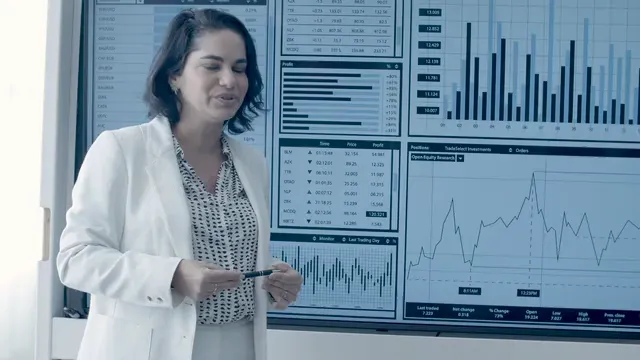Introduction
Pursuing a graduate degree in statistics is more than just hitting the books. It’s about diving headfirst into a world where data reigns supreme. Statisticians play a pivotal role in various industries, from finance to healthcare. They analyze data, draw insights, and help companies make informed decisions. In an era where data is the new oil, the demand for skilled statisticians is skyrocketing.
Why is this the case? Well, industries are now swimming in data. Companies need experts who can interpret this information to glean insights. Whether it’s predicting market trends, improving patient outcomes in healthcare, or optimizing operations in manufacturing, statisticians are the unsung heroes behind the scenes. The profession is booming, and it shows no signs of slowing down.
This article aims to guide you through the maze of options for graduate programs in statistics. We’ll cover the best programs available today, their rankings, and key details to consider when choosing the right path for you. By the end, you’ll have a clearer picture of which program fits your career aspirations and personal preferences. So, grab your calculator, and let’s crunch some numbers!

Overview of Statistics Graduate Programs
What is Statistics?
Statistics is the science of collecting, analyzing, and interpreting data. It involves using mathematical theories and methodologies to make sense of complex information. Statisticians utilize various techniques, including hypothesis testing, regression analysis, and probability theory, to derive meaningful insights from data sets.
In the real world, statistical knowledge is essential for making informed decisions. For example, businesses rely on statistics to forecast sales and assess customer satisfaction. In healthcare, statisticians analyze clinical trials to determine the effectiveness of treatments. Even in sports, teams utilize statistics to evaluate player performance and strategize for games.
The importance of statistical knowledge cannot be overstated. In a world increasingly driven by data, those equipped with statistical skills hold the keys to unlocking valuable insights. Whether you’re aiming for a job in data science, finance, or public health, a solid grounding in statistics is your ticket to success. Understanding statistics allows you to navigate the vast sea of data and make sound decisions based on empirical evidence, not just gut feelings.
To enhance your understanding, consider picking up a copy of Statistics for Data Science: How to Use Statistics to Analyze Data. This book provides a solid foundation for anyone looking to dive deeper into the world of data analytics.
In the following sections, we’ll explore various types of graduate degrees in statistics, ensuring you find the perfect fit for your career goals and academic interests.

Types of Graduate Degrees in Statistics
Master of Science (MS) vs. Master of Arts (MA)
When it comes to graduate degrees in statistics, the choice often boils down to two main types: the Master of Science (MS) and the Master of Arts (MA).
The Master of Science (MS) is typically more focused on quantitative analysis and research. Students often engage in rigorous coursework that involves advanced statistical methods, data analysis, and even a thesis requirement. This degree is perfect for those looking to dive deep into statistical theories and methodologies. If you’re interested in a program that emphasizes applied statistics for social science research, consider the Master of Science in Applied Statistics for Social Science Research.
The Master of Science in Applied Statistics is a strong choice for those interested in applying statistical methods in social science contexts. Learn more about this program here.
On the other hand, the Master of Arts (MA) often emphasizes the practical application of statistics. While it includes foundational statistics courses, the MA program might lean more toward real-world applications and less on theoretical frameworks. This degree is ideal for those who want to apply statistical methods in various fields such as social sciences, humanities, or even business.
Understanding these distinctions can help you choose the path that aligns with your career aspirations and academic interests.

Ph.D. in Statistics
For those aiming for the stars, a Ph.D. in Statistics is the ultimate academic achievement. This degree is crucial for anyone interested in pursuing research or teaching at the university level. Ph.D. programs provide deep dives into advanced statistical methodologies and often require students to conduct original research.
A Ph.D. opens doors to academia, positions in research institutions, and high-level roles in industry. Graduates can lead studies, influence policy, or even teach the next generation of statisticians. If you’re passionate about statistics and want to make a meaningful impact, a Ph.D. could be your golden ticket.
Top-Ranked Statistics Graduate Programs
Methodology Behind Rankings
When it comes to finding the best statistics graduate programs, understanding how these programs are ranked can be enlightening. Rankings typically rely on several key factors, including peer assessments, research impact, and academic reputation.
Prominent organizations like US News & World Report and QS World University Rankings gather data through surveys sent to academic professionals. They ask these experts to evaluate programs based on criteria such as faculty credentials, research output, and overall quality.
US News, for example, focuses heavily on peer assessments and research activity. Meanwhile, QS considers academic reputation, employer reputation, and research impact to create a well-rounded view of a program’s standing.
These rankings help prospective students identify programs that not only boast impressive credentials but also align with their personal and professional goals. After all, choosing the right program is a significant step toward a successful career in statistics.
By understanding the methodology behind these rankings, you can better navigate your options and select a program that suits your academic and career aspirations. Whether you’re eyeing Stanford, MIT, or another top institution, knowing what factors contribute to their rankings can guide your decision-making process.

Detailed List of Top Programs
1. Stanford University
– Location: Stanford, CA
Rank: #1 in Statistics
Key Program Highlights: Stanford University shines with a stellar peer assessment score of 4.9. The program emphasizes a blend of theoretical foundations and real-world applications. Students are encouraged to engage in innovative research, benefiting from access to cutting-edge resources. With a diverse faculty and interdisciplinary opportunities, it’s no wonder Stanford is a top choice for aspiring statisticians.

2. University of California—Berkeley
– Location: Berkeley, CA
Rank: #2 in Statistics
Key Program Highlights: The University of California—Berkeley boasts a peer assessment score of 4.8, reflecting its strong academic reputation. The program is known for its rigorous curriculum and a focus on applied statistics. With a commitment to research excellence, Berkeley offers rich opportunities for students to collaborate with leading experts in the field.
3. Harvard University
– Location: Cambridge, MA
Rank: #3 in Statistics (tie)
Key Program Highlights: Harvard University holds a peer assessment score of 4.6. The program is renowned for its emphasis on Bayesian statistics and causal inference. Students benefit from small class sizes, allowing for personalized attention and mentorship. Harvard’s extensive alumni network also provides valuable connections in the industry.
4. University of Chicago
– Location: Chicago, IL
Rank: #3 in Statistics (tie)
Key Program Highlights: The University of Chicago shares a peer assessment score of 4.6, highlighting its strong academic standing. Known for its theoretical approach, the program prepares students for advanced careers in academia and industry. Students enjoy access to innovative research projects and a collaborative environment, fostering intellectual growth.
5. Carnegie Mellon University
– Location: Pittsburgh, PA
Rank: #5 in Statistics (tie)
Key Program Highlights: Carnegie Mellon University offers a peer assessment score of 4.4. The program emphasizes a balance between theoretical knowledge and practical application. With a focus on statistical computing and data analysis, students are well-prepared for careers in data-intensive fields. The university’s strong ties to the tech industry enhance job placement opportunities.

6. Columbia University
– Location: New York, NY
Rank: #5 in Statistics (tie)
Key Program Highlights: Columbia University also holds a peer assessment score of 4.4, showcasing its robust academic reputation. The program is situated in a major business hub, providing networking opportunities with industry leaders. Students benefit from a flexible curriculum that allows for specialization in various statistical applications.
7. Duke University
– Location: Durham, NC
Rank: #7 in Statistics (tie)
Key Program Highlights: Duke University has a peer assessment score of 4.3. The program is recognized for its strong focus on biostatistics and interdisciplinary collaboration. Students are encouraged to engage in impactful research while being supported by a dedicated faculty. Duke’s vibrant campus life also enhances the overall graduate experience.
8. University of Michigan—Ann Arbor
– Location: Ann Arbor, MI
Rank: #7 in Statistics (tie)
Key Program Highlights: The University of Michigan—Ann Arbor earns a solid peer assessment score of 4.3. Its statistics program offers a unique blend of theoretical knowledge and practical applications. Students benefit from a diverse curriculum that encompasses advanced statistical methods, data analysis, and interdisciplinary collaboration. The faculty is known for their research excellence, providing students with ample opportunities to engage in meaningful projects. Plus, the vibrant campus life makes it a great place to learn and grow.

9. University of Pennsylvania
– Location: Philadelphia, PA
Rank: #7 in Statistics (tie)
Key Program Highlights: The University of Pennsylvania, another contender with a peer assessment score of 4.3, is renowned for its innovative approach to statistics. The program emphasizes real-world applications and equips students with essential skills in data science and analytics. With a strong focus on interdisciplinary studies, students can collaborate across various fields. The faculty consists of leading experts whose research impacts both academia and industry, offering students a chance to learn from the best.
10. University of Washington
– Location: Seattle, WA
Rank: #7 in Statistics (tie)
Key Program Highlights: The University of Washington boasts a peer assessment score of 4.3. Its statistics program is celebrated for its rigorous curriculum and research opportunities. Students engage in hands-on learning experiences, often collaborating on projects that address real-world challenges. The program’s strong connections to the tech industry in Seattle provide students with invaluable networking opportunities. With a commitment to fostering innovation, the University of Washington prepares graduates for success in various career paths.

Program Features to Consider
Internships and Job Placement
Internships play a crucial role in a statistics graduate program. They bridge the gap between theory and practice. Students gain hands-on experience, applying their knowledge in real-world settings. This experience is invaluable for building a professional network too. Many programs emphasize internship opportunities. This focus enhances students’ resumes before they even graduate. For insights on upcoming opportunities, check out the Statistics Internships Summer 2024.
Internships are crucial for gaining practical experience in statistics and enhancing your resume. Explore summer internship opportunities here.
Job placement rates are another essential factor to consider. Graduates from top statistics programs often enjoy high employment rates. For example, schools like Stanford and Berkeley report impressive placement stats. Many students land jobs shortly after graduation. This is largely due to strong connections with industry leaders. Employers often seek graduates from well-respected programs, making job hunting easier for these individuals.
To further boost your job prospects, consider adding skills in programming. A great resource for this is R Programming for Data Science. This book will equip you with the necessary skills to navigate data analysis effectively.

Location and Campus Life
When choosing a graduate program, geographical location matters. Urban campuses often provide access to various industries. This proximity can lead to internships and job opportunities. For instance, schools in tech hubs like San Francisco attract companies looking for talent. This can be a significant advantage for students.
Campus culture also plays a vital role in the graduate experience. A supportive environment fosters collaboration and camaraderie. Look for programs that encourage networking and peer support. Resources such as libraries, labs, and career services are essential too. They can significantly enhance the educational experience. Finding a balance between academic rigor and a vibrant campus life can lead to lasting friendships and professional connections.

Admissions Requirements and Application Process
General Application Requirements
Most statistics graduate programs require a solid foundation. Applicants typically need a bachelor’s degree in statistics or a related field. A minimum GPA of around 3.0 is often expected. GRE scores are commonly required; however, trends show some programs are moving away from this requirement. Letters of recommendation add weight to your application, especially from faculty or professionals familiar with your work.
In addition to academic credentials, relevant experience can be a game changer. Internships, research projects, or work experience in statistics can strengthen your application. Programs value candidates who demonstrate both academic prowess and practical skills.

Tips for a Successful Application
Crafting a compelling statement of purpose is key. This document should reflect your passion for statistics and your career goals. Highlight any relevant experiences, such as internships or research. Admissions committees appreciate applicants who clearly articulate their interests.
Furthermore, relevant experience can make your application stand out. Engage in internships or research projects during your undergraduate studies. This not only enhances your resume but also gives you practical knowledge. It shows you’re serious about pursuing a career in statistics.

Financial Aid and Scholarships
Financing graduate education can be daunting. Fortunately, various financial aid options are available. Graduate students can access federal loans and grants by filling out the FAFSA. Many universities also offer scholarships specifically for statistics students.
Moreover, teaching assistantships can provide both financial support and valuable experience. These positions often involve assisting professors with research or teaching duties. They can help offset tuition costs while enhancing your skills. Organizations such as the American Statistical Association also offer scholarships and grants. Taking advantage of these resources can ease the financial burden of graduate school.
Speaking of financial management, consider investing in a Planner and Journal. This can help you keep track of deadlines and manage your time efficiently during your studies.

Career Opportunities with a Statistics Graduate Degree
Job Roles and Salaries
Graduating with a statistics degree opens doors to various career paths. Common job titles include Statistician, Data Scientist, and Biostatistician. Each role offers unique opportunities and challenges. Statisticians typically work in research and consulting, analyzing data to inform business decisions. Data Scientists, on the other hand, often focus on big data and machine learning, extracting insights from vast data sets. Biostatisticians work mainly in healthcare, using statistical methods to analyze clinical data.
Salary expectations vary by role and location. Statisticians earn an average of about $88,000 annually. Data Scientists tend to command higher salaries, averaging around $100,000. Biostatisticians can also earn competitive salaries, especially in pharmaceutical companies. The demand for skilled professionals in these fields continues to grow, making a statistics graduate degree a lucrative investment.

Job Market Trends
The job market for statistics professionals is booming. The U.S. Bureau of Labor Statistics projects a 30% growth in jobs for statisticians and data scientists over the next decade. This growth is driven by the increasing reliance on data in decision-making across industries.
Industries such as technology, healthcare, and finance are particularly keen on hiring statisticians. Companies are looking for experts who can analyze data and provide actionable insights. As data generation continues to rise, the need for skilled statisticians will only increase. This trend indicates a bright future for graduates in this field.

Conclusion
Choosing the right statistics graduate program is crucial for your career. With the increasing demand for statisticians, a well-chosen program can set you on the path to success. Consider your career goals and personal preferences when evaluating programs. Take the time to research various options, and don’t hesitate to reach out to current students or alumni for insights. By doing so, you’ll be better equipped to make an informed decision that aligns with your aspirations. Start your journey today, and explore the possibilities that await in the world of statistics!
Please let us know what you think about our content by leaving a comment down below!
Thank you for reading till here 🙂
All images from Pexels




